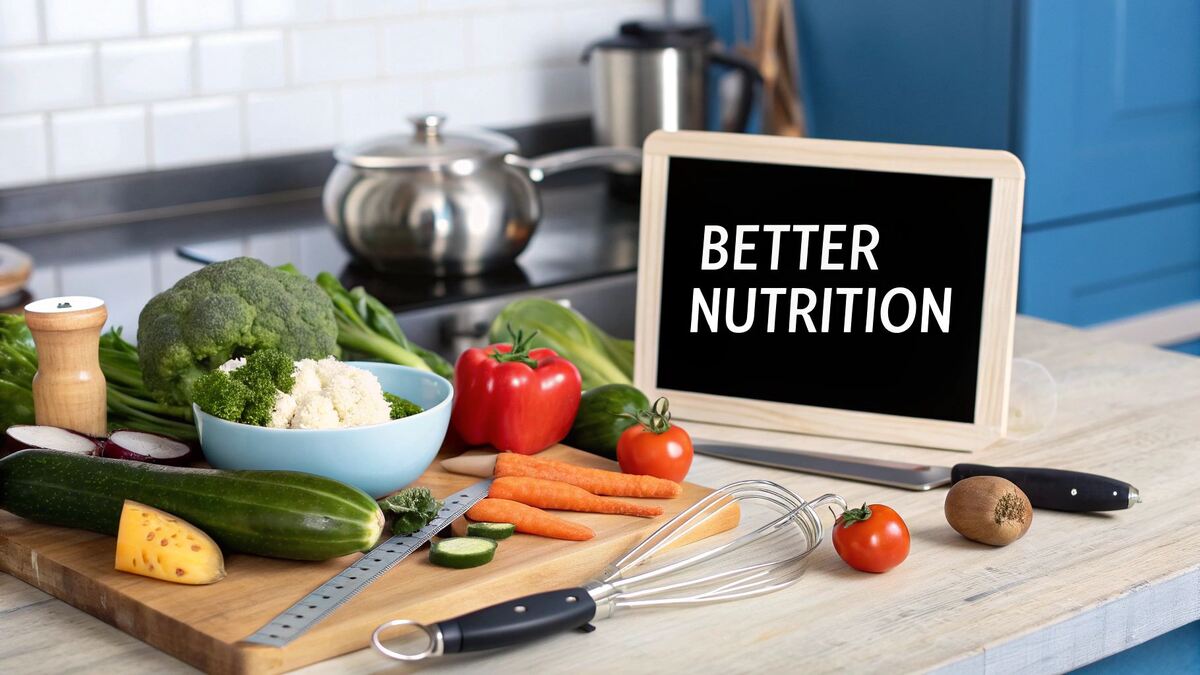When you get right down to it, a meal plan for weight loss that actually works is built on a single, simple idea: burning more calories than you eat. But the secret isn't drastic cuts. The sweet spot is a small, consistent calorie deficit of about 300-500 calories a day.
This approach is what helps you lose a steady one to two pounds a week without feeling constantly hungry or exhausted. It's the difference between a temporary diet and a sustainable plan that becomes part of your life.
Laying the Groundwork for Your Plan
Before you even think about what recipes to make, you have to build your foundation. This part isn’t about food; it’s about figuring out the numbers that will actually drive your results. A truly effective meal plan starts with a solid understanding of what your body personally needs.
Find Your Daily Calorie Target
First things first, you need a daily calorie goal. Think of this not as a restrictive rule, but as your starting line. This number is based on your Basal Metabolic Rate (BMR)—that’s the energy your body uses just to exist—plus all the calories you burn from walking, working, and exercising.
Online calculators can give you a ballpark figure, but for a more accurate number, I always recommend a hands-on approach:
- Find your baseline: For a few days, just track what you normally eat without trying to change anything. This gives you your maintenance calories—the amount that keeps your weight stable.
- Create a small deficit: Once you have that number, simply subtract 300 to 500 calories. This creates a gentle deficit that promotes fat loss while keeping your energy up and preserving muscle.
I see people make this mistake all the time: they slash their calories way too aggressively right from the start. That can backfire by slowing down your metabolism and leading to total burnout. Trust me, staying consistent with a smaller deficit beats extreme, short-term dieting every single time.
It's no surprise so many people are looking for structured eating plans. The global market for weight loss products and services is valued at a staggering $297.43 billion and is expected to nearly double. This just shows how many of us are searching for a reliable strategy, and a smart meal plan for weight loss is one of the best tools out there. You can get more insights on these growing market trends and what they mean for health-conscious individuals.
Before we move on, let's look at some sample calorie targets. These are just estimates to give you a starting point, and you'll want to adjust them based on your own progress.
Sample Daily Calorie Targets for Weight Loss
| Activity Level | Estimated Daily Calories for Women | Estimated Daily Calories for Men |
|---|---|---|
| Sedentary (little to no exercise) | 1,400-1,600 | 1,800-2,000 |
| Lightly Active (exercise 1-3 days/week) | 1,600-1,800 | 2,000-2,200 |
| Moderately Active (exercise 3-5 days/week) | 1,800-2,000 | 2,200-2,400 |
| Very Active (exercise 6-7 days/week) | 2,000-2,200 | 2,400-2,600 |
Again, these are just general guidelines. The best way to know if your target is right is to see how your body responds after a week or two and adjust from there.
Get Your Macros Right
Once your calorie target is set, the next step is to look at your macronutrients: protein, carbs, and fats. Getting the right balance is the key to feeling full, staying energized, and supporting all your body's functions while you lose weight.
A fantastic starting point for most people is a 40/30/30 split. Here's what that looks like:
- 40% Carbohydrates: Stick to complex carbs like oats, quinoa, brown rice, and sweet potatoes. They provide slow-release energy that keeps you going for hours.
- 30% Protein: Lean protein is your best friend for weight loss. Sources like chicken, fish, beans, and lentils help you hold onto muscle and are amazing at keeping hunger at bay.
- 30% Fats: Don't fear the fat! Healthy fats from avocados, nuts, seeds, and olive oil are essential for hormone balance and making you feel satisfied after a meal.
This balanced setup ensures your body has everything it needs to function at its best while you work toward your goal.
Building a Balanced Plate for Fat Loss
Okay, you've got your calorie and macro targets. Now what? Turning those numbers into actual meals you want to eat is where the real work—and the real success—begins. A good meal plan for weight loss isn't about obsessively weighing every morsel of food. It's about learning how to build a plate that just works.
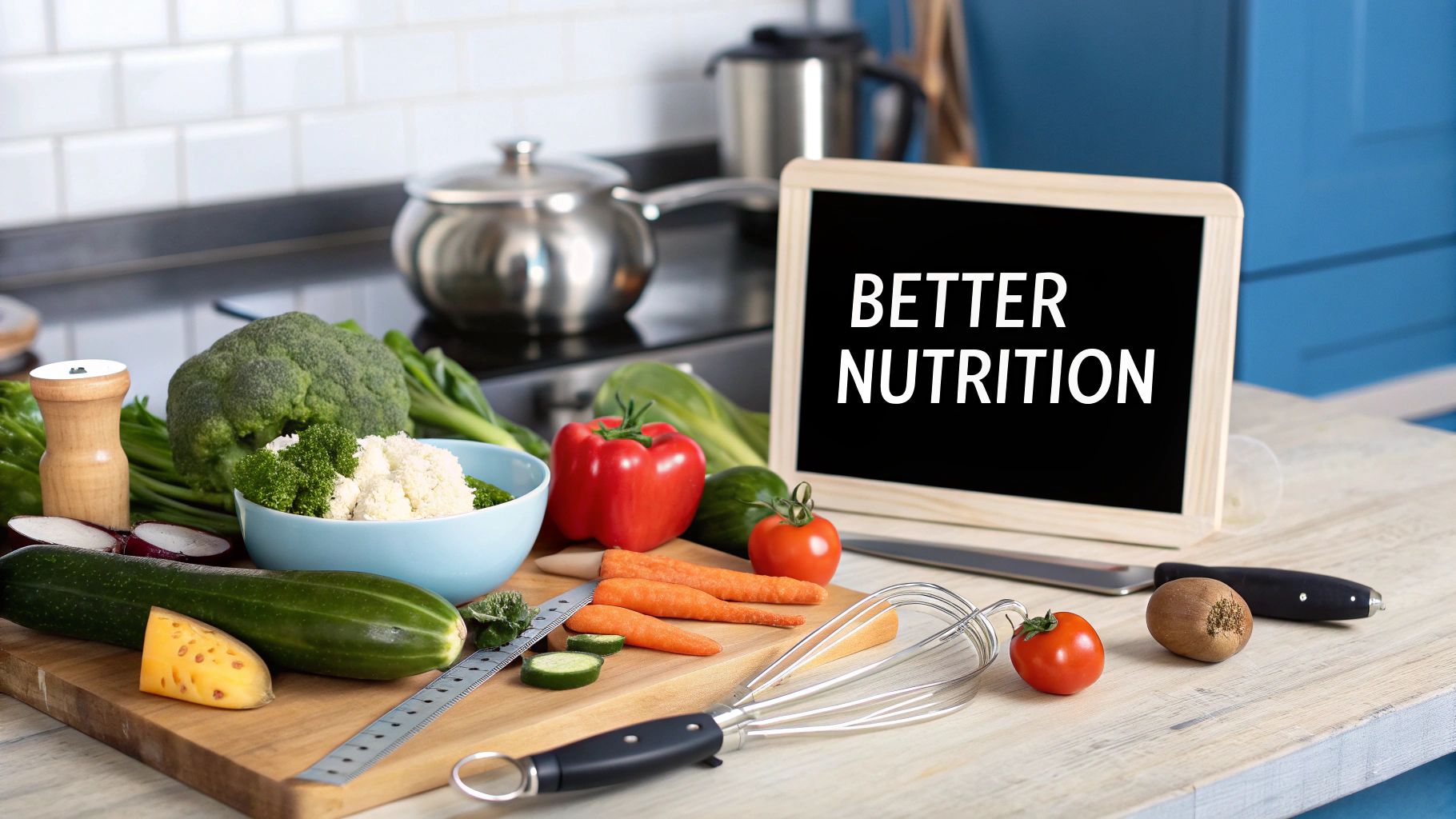
This is why I love the "plate method." It’s a dead-simple visual shortcut that takes the agonizing guesswork out of portion sizes. By mentally dividing your plate into a few key sections, you'll naturally create a meal that fuels your body and supports fat loss, no food scale required.
The Plate Method Explained
Think of your plate like a pie chart. The goal is to fill each slice with the right stuff to keep you full, protect your muscle mass, and give you steady energy throughout the day.
Here’s how it breaks down:
- Fill half (½) your plate with non-starchy vegetables. We're talking broccoli, leafy greens, bell peppers, asparagus, you name it. They're loaded with fiber and nutrients but incredibly low in calories, making them your secret weapon for feeling satisfied.
- Fill one-quarter (¼) of your plate with lean protein. This part is non-negotiable. Protein is critical for satiety and muscle repair. Think chicken breast, fish, tofu, lentils, or even a scoop of Greek yogurt.
- Fill the last quarter (¼) of your plate with complex carbohydrates. This is your energy source. Stick with whole-food options like quinoa, brown rice, sweet potatoes, or whole-wheat pasta for slow-releasing fuel.
This simple formula is the backbone of many incredibly successful eating plans. Take the Mediterranean diet, for example. It's consistently ranked as one of the best for overall health and weight loss because it's built on this exact balance of whole foods. In fact, a panel of experts recently ranked it highest in 12 of 21 health categories, celebrating its sustainable and enjoyable approach. You can learn more about why this diet tops the charts for weight loss and see how its principles align with this method.
Don't Forget Healthy Fats
Healthy fats are the final, crucial touch. They don't get a main section of the plate, but they're added in small, smart portions to boost flavor, health, and how full you feel.
One of the biggest mistakes I see people make is cutting out fats entirely. Your body needs healthy fats for hormone production and nutrient absorption. Plus, they make your meals taste better and keep you satisfied for hours.
Here are a few easy ways to add them in:
- Toss in a thumb-sized portion of avocado or a small handful of nuts.
- Drizzle a tablespoon of good olive oil over your salad or roasted veggies.
- Sprinkle a tablespoon of chia seeds or ground flaxseed onto your meal.
When you start building your plates this way, you shift from a mindset of restriction to one of abundance. You're not just creating meals for weight loss; you're creating meals that are genuinely delicious and satisfying to eat, day in and day out.
Your Flexible 7-Day Meal Plan Template
Theory is great, but putting it into practice is where a meal plan for weight loss really starts to work. This isn't about a rigid, do-or-die diet. Think of it as a flexible blueprint you can mold to fit your own life and tastes. The real goal is to build a week of satisfying, whole-food meals that keep your energy up and prevent those hunger crashes that can completely derail your progress.
A plan that actually works isn't built on feeling deprived. Instead, it’s all about consistency—usually three balanced meals and one or two smart snacks each day. This rhythm helps regulate your metabolism and keeps your blood sugar from going on a rollercoaster, making the whole process feel less like a temporary diet and more like a permanent, positive shift.
This visual breaks down the foundational steps for building your plan, from figuring out your calories to dialing in your macros and meal timing.
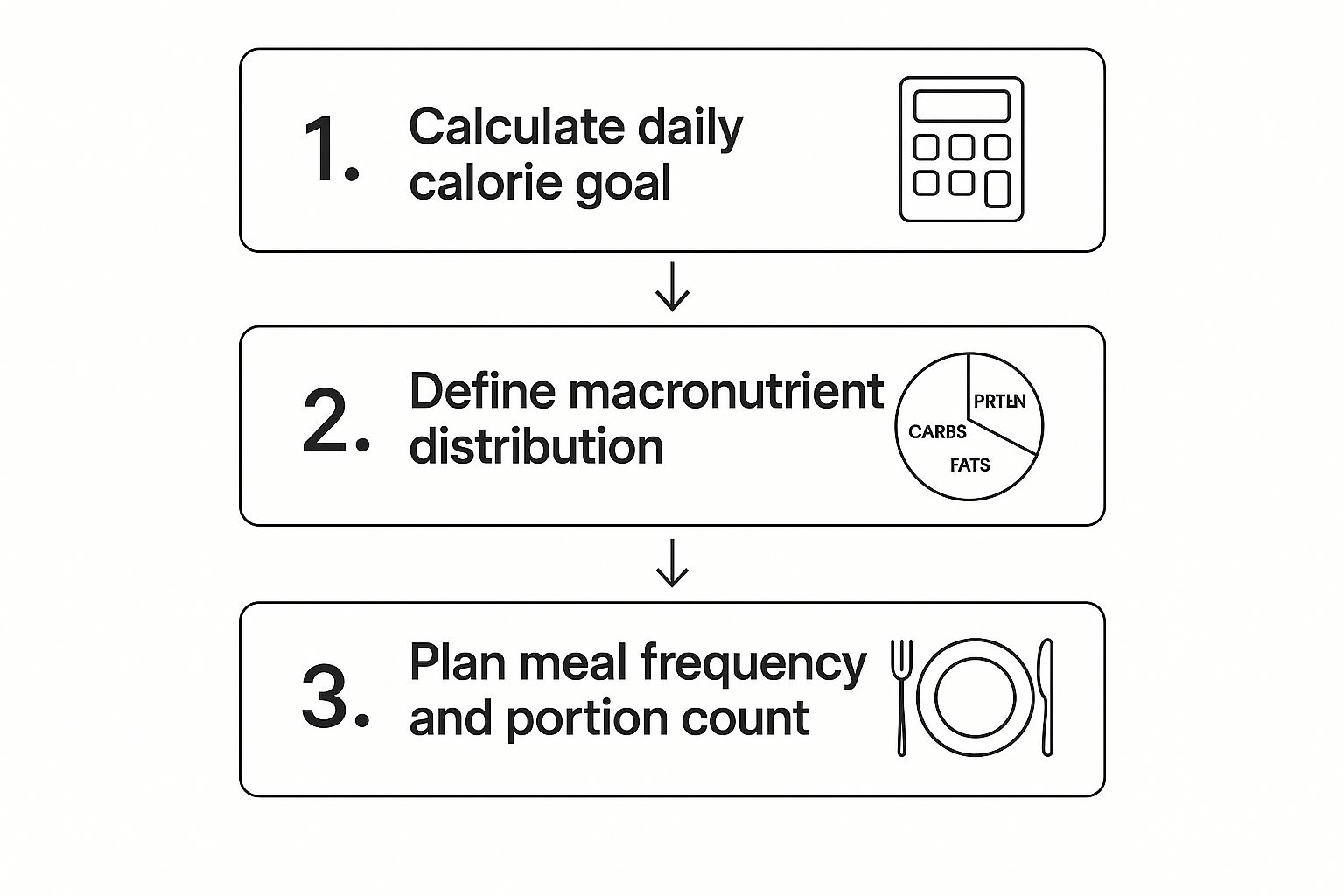
As you can see, creating your plan is a logical flow. It starts with your basic energy needs and then drills down into the nitty-gritty of what you're eating and when.
A Customizable Daily Framework
So, what does a typical day actually look like? The specific foods below are just ideas to get you started. The important part is the structure and the balance of nutrients in each meal, using that plate method we covered earlier as your guide.
- Breakfast (around 300-400 calories): Your mission here is to start the day with protein and fiber. This combination keeps you full and focused. Think Greek yogurt topped with fresh berries and a sprinkle of nuts, or a couple of scrambled eggs with a handful of spinach and a slice of whole-wheat toast.
- Lunch (around 400-500 calories): This meal needs to power you through the afternoon slump. A big salad loaded with grilled chicken, chickpeas, and a light vinaigrette is a classic for a reason. Another fantastic option is a quinoa bowl packed with roasted veggies and your protein of choice, like tofu or shrimp.
- Dinner (around 400-500 calories): You want something satisfying that won't leave you feeling overly stuffed before bed. A piece of baked salmon with a side of asparagus and a small sweet potato is perfect. A hearty lentil soup with a simple side salad also fits the bill wonderfully.
- Snacks (1-2 a day, about 150-200 calories each): Think of snacks as a bridge to get you from one meal to the next without getting ravenous. An apple with a tablespoon of peanut butter, a hard-boiled egg, or a small handful of almonds are all smart, effective choices.
The best meal plan on earth is the one you can actually stick with. Don't ever be afraid to swap things around. If you can't stand salmon, use chicken. Tired of quinoa? Switch to brown rice. Flexibility is your secret weapon for long-term success.
This framework gives you the structure, but the magic happens when you make it your own. If you want to take the guesswork out of the process, you might be interested in a tool that can generate a customized meal plan based on your specific goals and food preferences.
Example 7-Day Meal Plan Framework
To help you visualize how this all comes together over a full week, here’s a sample outline. Notice how it uses leftovers to save time and incorporates a good variety of foods to keep things from getting boring.
| Day | Breakfast Idea | Lunch Idea | Dinner Idea | Snack Ideas |
|---|---|---|---|---|
| Monday | Oatmeal with Berries & Nuts | Grilled Chicken Salad | Turkey Meatballs with Zucchini Noodles | Apple with Almond Butter |
| Tuesday | Scrambled Eggs with Spinach | Leftover Turkey Meatballs | Baked Cod with Roasted Broccoli | Greek Yogurt |
| Wednesday | Greek Yogurt with Granola | Quinoa Bowl with Black Beans | Chicken and Vegetable Skewers | Handful of Walnuts |
| Thursday | Smoothie with Protein Powder | Leftover Chicken Skewers | Lentil Soup | Hard-Boiled Egg |
| Friday | Whole-Wheat Toast with Avocado | Tuna Salad Lettuce Wraps | Lean Beef Stir-fry | Cottage Cheese |
| Saturday | Protein Pancakes | Large Veggie & Hummus Plate | Homemade Turkey Burger (no bun) | Carrots and Hummus |
| Sunday | Cottage Cheese with Fruit | Leftover Beef Stir-fry | Roasted Chicken with Veggies | Rice Cakes with Peanut Butter |
This table is just a starting point. Use it as inspiration to build a week of meals you genuinely look forward to eating. That's the key to making it last.
Making Meal Prep Work for You
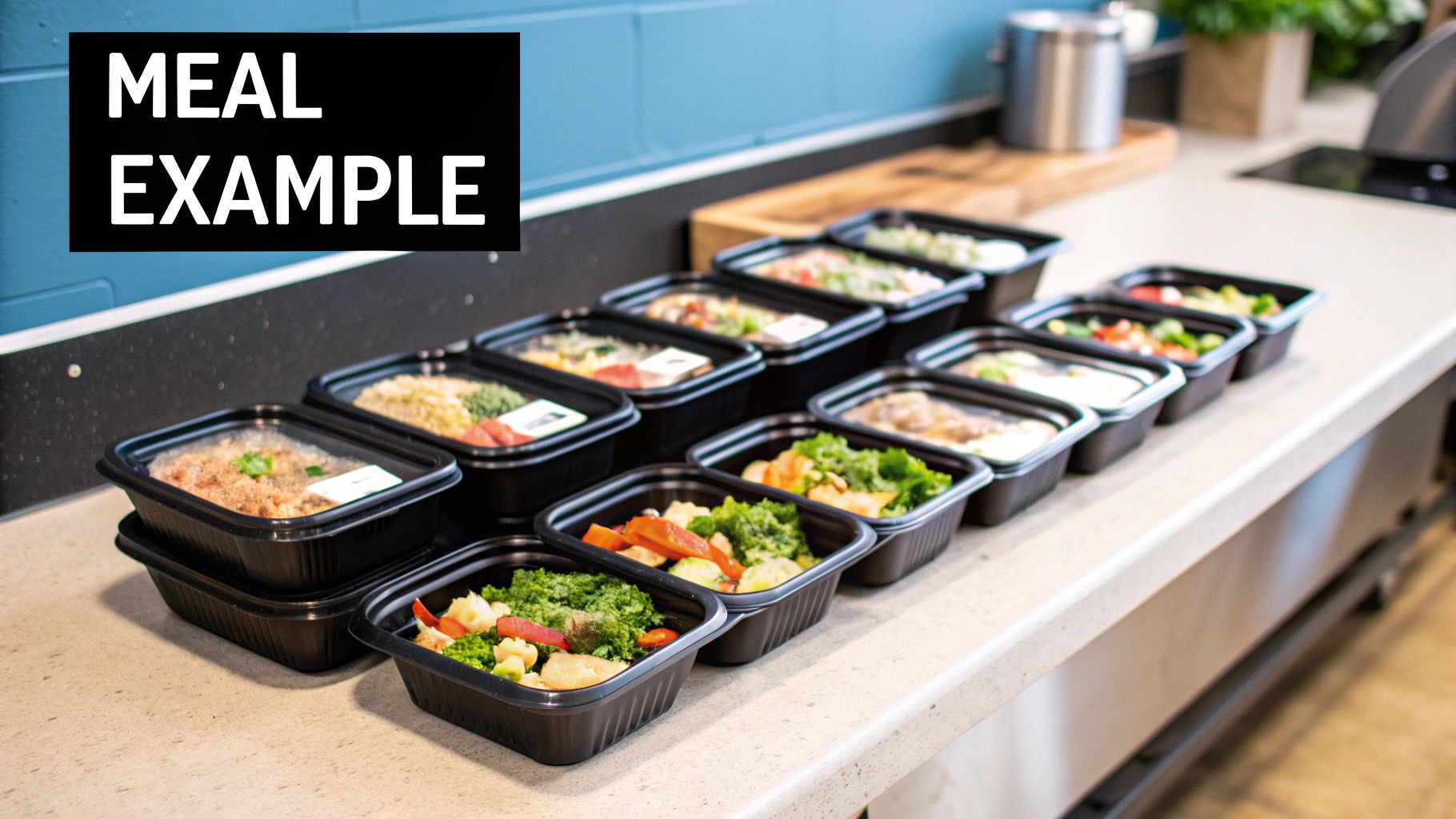
Let’s be honest: a fantastic meal plan for weight loss is just a piece of paper if you don't actually follow it. This is where meal prep comes in and completely changes the game. It’s the simple act of preparing meals ahead of time, making the healthy choice the easiest choice.
And no, this doesn't mean you have to lose your entire Sunday to the kitchen. Good meal prep isn't about cooking seven elaborate dinners at once. It's about being strategic with your time so you're not left staring into the fridge, tired and hungry, on a busy weeknight.
Different Approaches to Meal Prep
There’s no one-size-fits-all method here. The best way to meal prep is whatever way you’ll actually stick with. Finding a rhythm that clicks with your lifestyle is what turns this from a chore into a sustainable habit.
Here are a few popular strategies I've seen work wonders:
- Batch Cooking Staples: This is my go-to recommendation for beginners. Just cook up big batches of versatile basics—think quinoa, brown rice, roasted sweet potatoes, or a big tray of grilled chicken breasts. You can then mix and match these all week to build different bowls, salads, and sides. It’s the best way to avoid getting bored.
- Assembled Grab-and-Go Meals: For those with chaotic schedules, having full meals ready to go is a lifesaver. This could be mason jar salads, pre-portioned containers with salmon and asparagus, or overnight oats sitting in the fridge. When it’s time to eat, there's zero effort involved.
- Ingredient Prep: Maybe you like cooking fresh each night. In that case, just do the prep work ahead of time. Spend an hour chopping all your veggies, dicing onions, or marinating your proteins. This simple step can slash your nightly cooking time from 30 minutes to just 10.
By carving out just an hour or two on a Sunday, you’re basically setting your future self up for a week of wins. It takes the daily guesswork out of eating well.
Setting Yourself Up for Success
To make your prep session feel less like a frantic scramble and more like a smooth, efficient process, a little forethought is key. It's about creating a system that works for you.
The real magic of meal prep is that it makes your healthy decision ahead of time. When you’re tired on a Wednesday night, you don’t have to decide to eat well—the decision has already been made for you.
To really nail your routine, try focusing on these three things:
- Shop Smart: Never go to the grocery store without a list built from your meal plan. This is your best defense against impulse buys and ensures you don't forget that one crucial ingredient.
- Use Quality Containers: I can't stress this enough. A good set of airtight, BPA-free containers is a worthy investment. Glass ones are my favorite because they can go straight from the fridge to the microwave or oven.
- Create a Simple Routine: Block out a specific two-hour window on your calendar. I put on a good podcast, turn up the music, and just get it done. Making it a non-negotiable appointment with yourself is how it becomes a habit.
This kind of system makes sticking to your meal plan for weight loss feel almost automatic. It's not about being perfect; it's just about making the right choice the most convenient one.
Overcoming Common Weight Loss Challenges
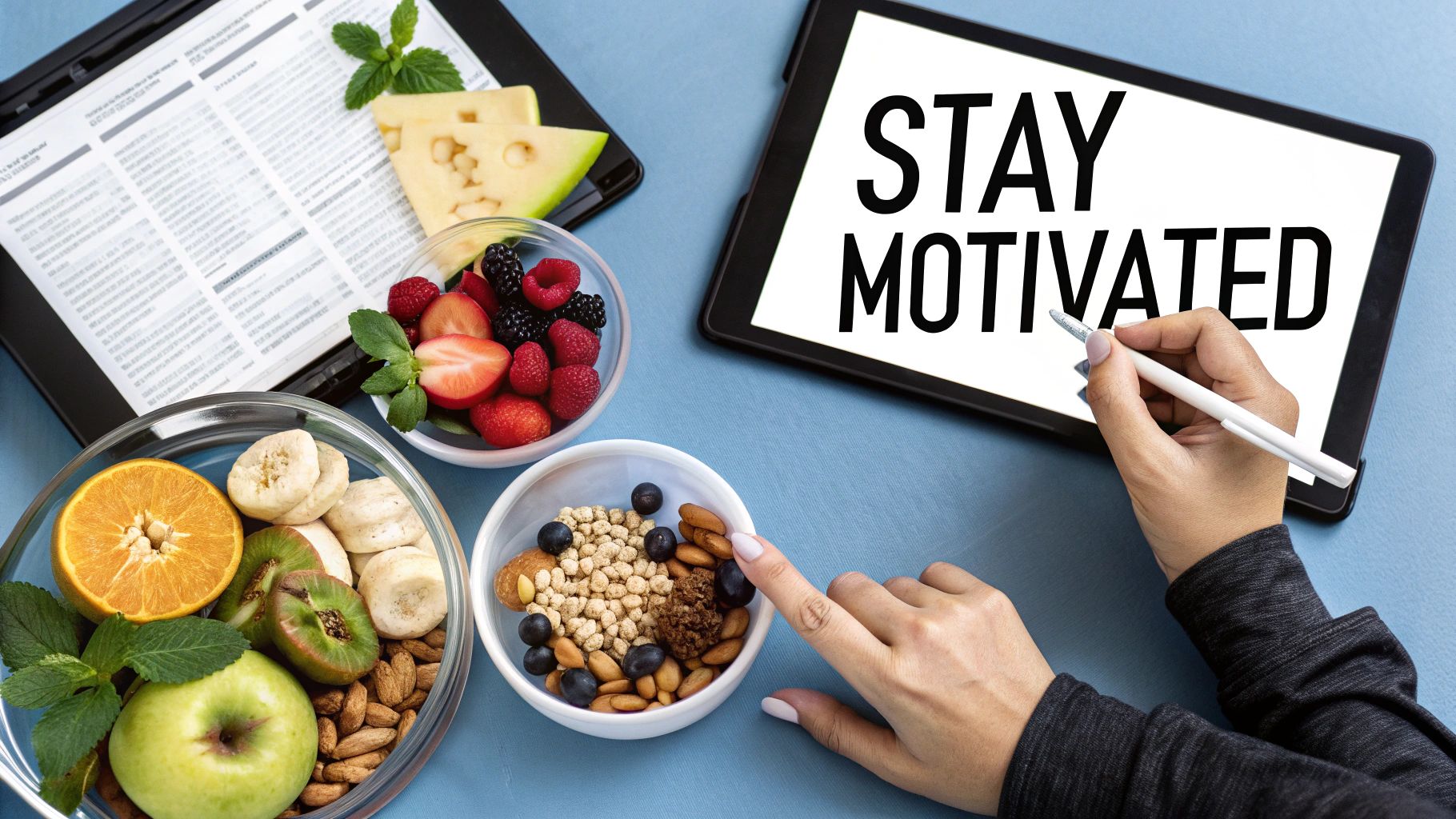
Let’s be realistic: a perfect week on your meal plan for weight loss is pretty rare. Life happens. You've got birthday parties, holiday dinners, and stressful days that seem designed to test your resolve. The secret to long-term success isn't about perfectly avoiding these things; it's about learning how to handle them without getting thrown off course.
The biggest mental shift is moving away from an "all-or-nothing" attitude. One meal that wasn't on the plan doesn't undo all your hard work. It's just a single moment in a long journey. The real goal is to build the skills to enjoy your life—special events and all—without feeling guilty or derailed.
Handling Social Events and Restaurant Meals
Going out to eat shouldn’t feel like a trap. With a little bit of foresight, you can absolutely stay on track and still have a great time. The trick is to make a plan before you even walk through the door.
Here are a few strategies I've seen work time and time again:
- Scout the Menu Online: Before you go, pull up the restaurant's menu on your phone. This gives you time to find a couple of solid, healthy options without the pressure of making a split-second decision when you're already hungry.
- Ask for Simple Swaps: Don't ever feel awkward about asking for what you need. Simple requests like "Can I get the sauce on the side?" or "Could I have steamed veggies instead of fries?" are incredibly common and can slash the calorie count of a dish.
- Look for Protein and Veggies: When in doubt, scan the menu for meals centered around lean proteins and vegetables. Grilled fish or chicken with a side salad is almost always a safe, satisfying bet.
Here's a pro tip: Never show up to a party starving. A small, protein-rich snack beforehand—like a Greek yogurt or a handful of almonds—can take the edge off your hunger. This little bit of prep makes it so much easier to make smart choices instead of diving for the first thing you see.
Breaking Through a Weight Loss Plateau
It's the moment everyone dreads: after weeks of steady progress, the scale just stops moving. This is a weight loss plateau, and trust me, it happens to almost everyone. It just means your body has adapted to your current routine.
Instead of getting frustrated, think of it as a signal to make a small, smart change. This isn't the time for drastic measures. Often, a tiny tweak is all you need to get things moving again.
Think about making one of these adjustments:
- Recalculate Your Calories: As you lose weight, your metabolism naturally slows down a bit. You might need to drop your intake by just 100-200 calories to reignite progress.
- Add a Little More Movement: You don't need to double your gym time. Just add an extra walk to your week or incorporate some light strength training. It all adds up.
- Shake Up Your Routine: Sometimes your body just needs a different signal. Try changing the types of foods you eat for a week or experiment with the timing of your meals.
It's also important to acknowledge that for many, healthy eating comes with a significant financial burden. Reports show the average cost of a healthy diet is $4.46 per person per day, a price that an estimated 2.6 billion people around the world can't afford. This economic reality complicates the journey, making affordable, nutrient-dense foods a crucial part of any realistic plan. You can discover more insights about food affordability on worldbank.org.
Celebrating Non-Scale Victories
Finally, you have to remember that the scale is just one tool—and not even the most important one. The mental side of weight loss is won by celebrating every single sign of progress, especially the ones that have nothing to do with a number.
These "non-scale victories" are often far more motivating in the long run. Start noticing and celebrating things like:
- Having more energy to get through your day.
- Your favorite jeans fitting a little looser.
- Feeling noticeably stronger during your workouts.
- Waking up feeling more rested after a good night's sleep.
Acknowledging these wins is what reinforces your new habits. It’s proof that all your effort is paying off in ways that truly improve your quality of life.
Frequently Asked Questions
https://www.youtube.com/embed/6FGX5JHjYHE
Diving into a new meal plan always brings up questions. It's completely normal to wonder about the specifics, especially when you're committing to a weight loss journey. Let's tackle some of the most common questions I hear from people just starting out.
Can I Still Eat My Favorite Foods?
Yes, and you absolutely should! This is a big one. The old-school mindset of "good" foods and "bad" foods is what sets people up for failure. A truly sustainable plan has to be flexible, which is why something like the 80/20 rule works so well.
The idea is simple: 80% of your meals are built around those nutrient-rich, whole foods that fuel your body and help you reach your goals. The other 20% is for that slice of birthday cake, a glass of wine with friends, or your favorite takeout.
I can't stress this enough: cutting out everything you love is a surefire way to burn out. It creates a cycle of restriction and craving that almost always ends in a binge. When you make room for your favorite foods, you remove the guilt and start building a lifestyle you can actually stick with.
This approach isn't about "cheating"; it's about balance. It's what allows you to see consistent, long-term results without feeling like you're constantly missing out.
What if I Stop Seeing Results Right Away?
First things first: breathe. Weight loss is never a perfectly straight line down. Aiming for a steady 1-2 pounds per week is a great, healthy target, but your body doesn't work like a calculator.
You'll have weeks where the scale doesn't budge. This is often due to things completely out of your control, like water retention, hormonal fluctuations (especially for women), or even muscle gain if you're working out. It's all part of the process.
Instead of fixating only on the scale, look for other signs of progress:
- Progress photos are a game-changer. Take them! You'll be amazed at the visual changes over a few weeks.
- How are your clothes fitting? That pair of jeans getting a little looser is a huge win.
- Check in with your energy. Do you feel stronger during workouts or less sluggish in the afternoon?
If a solid 3-4 weeks go by with zero change across the board despite being consistent, then it might be time for a small tweak. You could double-check your calorie targets or slightly trim your portion sizes—but please, don't make any drastic cuts. Small, patient adjustments are key.
Do I Need Expensive Health Foods to Lose Weight?
Not at all. In fact, some of the most effective weight loss plans are built on the simplest, most affordable foods you can find. You don't need fancy superfood powders or overpriced "diet" products to get results.
Your grocery list should be full of accessible staples. Think about:
- Inexpensive proteins like eggs, chicken thighs, beans, and lentils.
- Carbs that pack a punch, such as oats, brown rice, and potatoes.
- Whatever fruits and vegetables are in season and on sale.
Don't sleep on the freezer aisle! Frozen fruits and veggies are just as nutritious as fresh (sometimes even more so) and are incredibly budget-friendly. The goal is a balanced diet of real food, not a cabinet full of supplements—unless, of course, a doctor has specifically told you that you have a nutrient deficiency.
Ready to stop guessing and start seeing results? AI Meal Planner creates personalized meal plans based on your goals, preferences, and lifestyle. Get your custom plan today and make healthy eating simple and delicious. Start your journey with AI Meal Planner.
Article created using Outrank
AI-powered nutrition
Get Your Personalized Meal Plan
AI creates the perfect meals for your goals, lifestyle, and taste.
Start Your Journej
